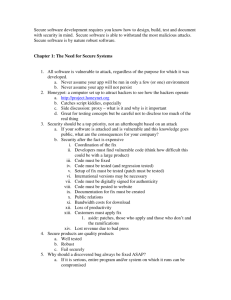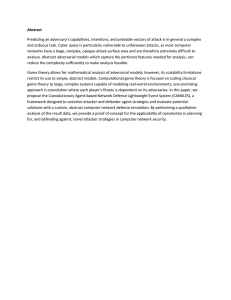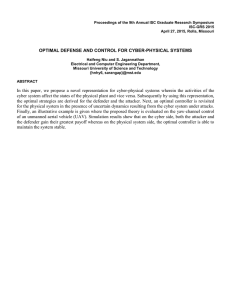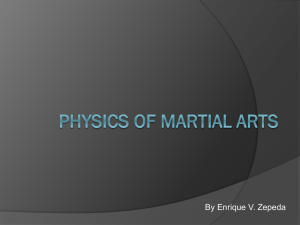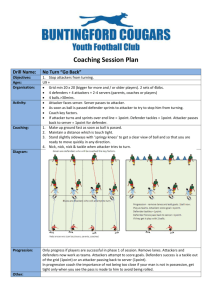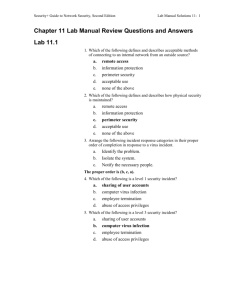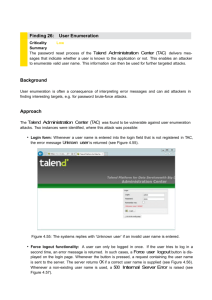Inference of Local Properties in Petri Nets Composed through an
advertisement
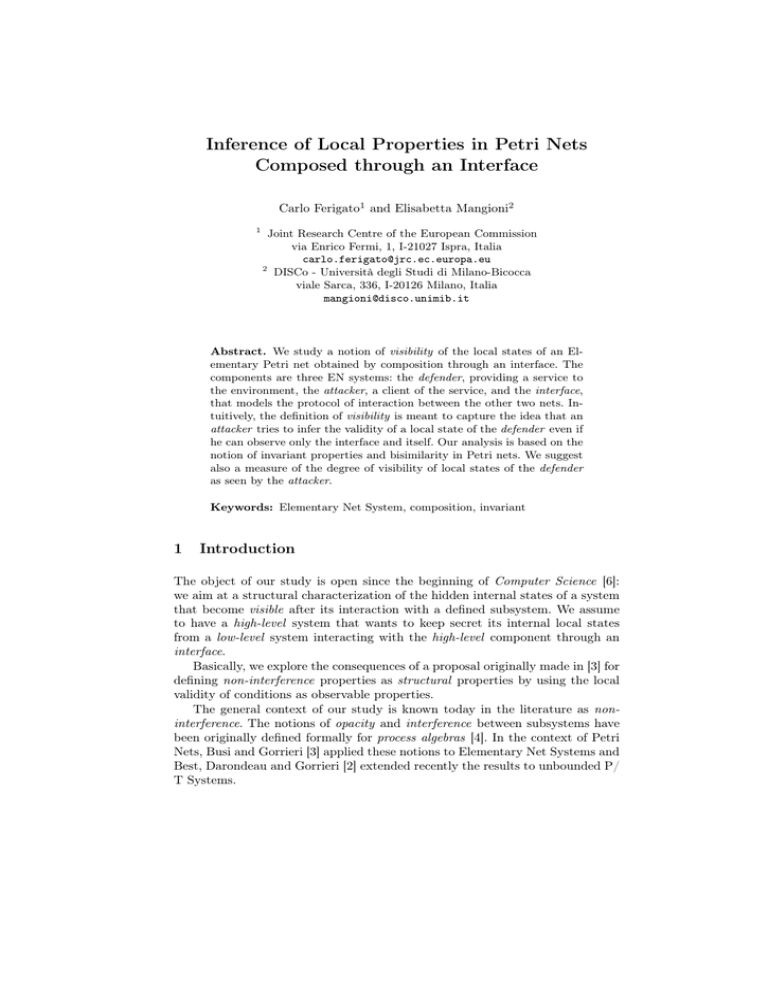
Inference of Local Properties in Petri Nets
Composed through an Interface
Carlo Ferigato1 and Elisabetta Mangioni2
1
Joint Research Centre of the European Commission
via Enrico Fermi, 1, I-21027 Ispra, Italia
carlo.ferigato@jrc.ec.europa.eu
2
DISCo - Università degli Studi di Milano-Bicocca
viale Sarca, 336, I-20126 Milano, Italia
mangioni@disco.unimib.it
Abstract. We study a notion of visibility of the local states of an Elementary Petri net obtained by composition through an interface. The
components are three EN systems: the defender, providing a service to
the environment, the attacker, a client of the service, and the interface,
that models the protocol of interaction between the other two nets. Intuitively, the definition of visibility is meant to capture the idea that an
attacker tries to infer the validity of a local state of the defender even if
he can observe only the interface and itself. Our analysis is based on the
notion of invariant properties and bisimilarity in Petri nets. We suggest
also a measure of the degree of visibility of local states of the defender
as seen by the attacker.
Keywords: Elementary Net System, composition, invariant
1
Introduction
The object of our study is open since the beginning of Computer Science [6]:
we aim at a structural characterization of the hidden internal states of a system
that become visible after its interaction with a defined subsystem. We assume
to have a high-level system that wants to keep secret its internal local states
from a low-level system interacting with the high-level component through an
interface.
Basically, we explore the consequences of a proposal originally made in [3] for
defining non-interference properties as structural properties by using the local
validity of conditions as observable properties.
The general context of our study is known today in the literature as noninterference. The notions of opacity and interference between subsystems have
been originally defined formally for process algebras [4]. In the context of Petri
Nets, Busi and Gorrieri [3] applied these notions to Elementary Net Systems and
Best, Darondeau and Gorrieri [2] extended recently the results to unbounded P/
T Systems.
In these latter works, non-interference is basically defined as language equivalence. The equivalent languages are, respectively, the one generated by the
restriction of the system to the low-level component alone, and the language
generated by the composition of the low-level component with any high-level
component.
The definition of non interference in terms of languages forces at considering
events as basic observable entities, but this is partly in contradiction with the
traditional view of events in nets as entities observable only indirectly, via the
modifications of their pre- and post-conditions.
Since we consider as basic observables the local properties of systems represented by conditions, we call the property we describe visibility. In terms of
visibility, two interacting systems can be seen as defender and attacker. The
defender offers a service to the environment and wants to keep secret part of
its local states. The attacker uses the service of the defender and tries to get
information about its internal local states.
We will represent systems with Elementary Net (EN) systems, a basic model
of Petri Nets. The service is modeled by a third EN system called interface. The
interaction among these systems is given by the composition of the defender
and the attacker through the interface. By using standard techniques related to
S-invariants and bisimilarity in Petri Nets, we prove a theorem that allows us to
recognize the places of the interface visible to, at least, one attacker. Moreover, we
discuss the general cases of attackers bisimilar and non bisimilar to the interface.
In the conclusions, we propose a measure of the degree of visibility of conditions
as seen from the attacker.
2
Basic definitions
This section recalls basic definitions about net theory ([10]).
Definition 1. An Elementary Net (EN ) system is a quadruple N = (B, E, F, m0 ),
where B and E are distinct finite sets of conditions and events, F ⊆ (B × E) ∪
(E × B) is the flow relation, m0 ⊆ B is the initial case and
1. dom(F ) ∪ ran(F ) = B ∪ E.
2. ∀e ∈ E, p, q ∈ B : (p, e), (e, q) ∈ F ⇒ p 6= q
The preset of an element x ∈ B ∪E is defined by • x = {y ∈ B ∪E|(y, x) ∈ F };
the postset of x is given by x• = {y ∈ B ∪ E|(x, y) ∈ F }.
The structure of a net can be represented by a matrix M called the incidence
matrix. In this matrix there is a row for each condition, a column for each event
and the element (k, j) is set to 1 if there is an arc from the event ej to the
condition bk , −1 if there is an arc from bk to ej , 0 otherwise.
The behaviour of EN systems is defined through the firing rule which specifies when an event can occur, and how event occurrences modify the holding of
conditions. Let N be an EN system, e ∈ E and m ⊆ B. The event e is enabled
at m, denoted m [ei, if • e ⊆ m and e• ∩ m = ∅; the occurrence of e at m leads
from m to m0 , denoted m [ei m0 , iff m0 = (m \ • e) ∪ e• . Let denote the empty
word in E ∗ . It is possible to extend the firing rule to sequences of events in the
following way:
m [i m
∀e ∈ E, ∀w ∈ E ∗ , m [ewi m0 = m [ei m0 [wim00
and w is called firing sequence.
A subset m ⊆ B is a reachable marking of N if there exists a w ∈ E ∗ such
that m0 [wi m. The set of all reachable markings of N is denoted by [m0 i.
An EN system is 1-live if every event can fire in, at least, one reachable
marking.
Some properties of a net can be studied through the incidence matrix and its
invariants. An S-invariant associates weights to conditions so that the weighted
sum of tokens is the same in all reachable markings.
Definition 2. Let N be a net and let M be its incidence matrix. A vector I :
B → N is an S-invariant iff it is a solution of: IT ◦ M = 0.
Similarly, a T -invariant is defined as a vector J : E → N iff it is a solution
of: M ◦ J = 0.
An S-invariant is monomarked iff its coefficients are in {0, 1} and exactly one
condition corresponding to a 1 in the invariant belongs to the initial marking
m0 .
In the following, when we write Ni we will refer to an EN system: Ni =
(Bi , Ei , Fi , mi0 ).
Relations between EN systems can be expressed by N -morphisms ([7]), corb -morphisms are a special case of
responding to a form of partial simulation. N
N -morphisms and will be used in defining the operation of composition.
b -morphism from N1 to N2 is a pair (β, η), such that:
Definition 3. A N
1.
2.
3.
4.
5.
β ⊆ B1 × B2 , and β −1 : B2 → B1 is a total and injective function;
η : E1 →∗ E2 is a partial and surjective function;
if η(e1 ) is undefined, then β(• e1 • ) = ∅;
if η(e1 ) = e2 , then β(• e1 ) = • e2 and β(e1 • ) = e2 • ;
∀(b1 , b2 ) ∈ β : [b1 ∈ m10 ⇔ b2 ∈ m20 ].
b -morphisms reflect S-invariants ([1]), but do not preserve them.
N
We recall an operation of composition (defined in [8]) that composes two
EN systems, N1 and N2 , with respect to a third EN system NI called interface
because it expose the protocol of interaction between the two systems. The comb -morphisms, (β1 , η1 ) and (β2 , η2 ), respectively
position is driven by a pair of N
from N1 to NI , and from N2 to NI . In this way, N1 and N2 can be seen as
composed each one by a local component and a component isomorphic to NI .
Definition 4. Let Di = {b ∈ Bi |βi (b) 6= ∅}, and Gi = dom(ηi ).
We define N1 hNI iN2 = N = (B, E, F, m0 ) as follows:
1. B = (B1 \ D1 ) ∪ (B2 \ D2 ) ∪ BI ;
2. E = (E1 \ G1 ) ∪ (E2 \ G2 ) ∪ Esync ,
where Esync = {he1 , e2 i|e1 ∈ G1 , e2 ∈ G2 , η1 (e1 ) = η2 (e2 )};
3. F is defined by the following clauses:
(a) ∀b ∈ (Bi \ Di ), ∀e ∈ (Ei \ Gi ), i = 1, 2 we have (b, e) ∈ F ⇔ (b, e) ∈ Fi
and (e, b) ∈ F ⇔ (e, b) ∈ Fi ;
(b) ∀b ∈ (Bi \Di ), ∀e ∈ Gi , ∀ej ∈ E3−i and es = he, ej i if i = 1 or es = hej , ei
if i = 2, we have (b, es ) ∈ F ⇔ es ∈ E, (b, e) ∈ Fi and (es , b) ∈ F ⇔
es ∈ E, (e, b) ∈ Fi ;
(c) ∀b ∈ BI , ∀e = he1 , e2 i ∈ Esync we have (b, e) ∈ F ⇔ (β1−1 (b), e1 ) ∈
F1 , (β2−1 (b), e2 ) ∈ F2 and (e, b) ∈ F ⇔ (e1 , β1−1 (b)) ∈ F1 , (e2 , β2−1 (b)) ∈
F2 ;
4. m0 = (m10 \ D1 ) ∪ (m20 \ D2 ) ∪ mI0 .
From this construction it follows immediately that N = N1 hNI iN2 as above is
an EN system.
The pair (γi , δi ), with γi ⊆ B × Bi and δi : E → Ei defined as:
– γi = {(b, b)|b ∈ Bi \ Di } ∪ {(b, βi−1 (b))|b ∈ BI },
– ∀e ∈ Ei \ Gi : δi (e) = e, δ3−i (e) = undefined,
– ∀he1 , e2 i ∈ Esync : δi (he1 , e2 i) = ei .
b -morphism from N = N1 hNI iN2 to Ni , i = 1, 2.
is an N
Informally, the composition creates a new EN system with the original conditions, events and arcs local to the components plus the conditions of the interface
and the Cartesian product of the events to be synchronized. Synchronized events
are connected to the local conditions, if there is an arc in the components between
these objects, and to the conditions of the interface, if there is an arc in both
the components between these events and the inverse-image of the conditions of
the interface.
In Fig. 1 it is shown an example of the two EN systems to be composed and
b -morphisms are defined
the interface; in Fig. 2 there is the resulting net. The N
by identical labels on conditions and events.
b -morphisms assure that, if a component N1 is bisimComposition through N
ilar to the interface, then the composed net is bisimilar to the other component,
N2 [1].
Bisimulation relations have been introduced as an equivalence notion with
respect to event observation [5]. We define the observability of events of a system
by using a labelling function which associates the same label to different events,
when viewed as equal by an observer, and the label τ to unobservable events.
Definition 5. Let N = (B, E, F, m0 ) be an Elementary Net System, l : E →
L ∪ {τ } be a labelling function where L is the alphabet of observable actions and
τ 6∈ L the unobservable action. Let denote the empty word in both E ∗ and L∗ .
The function l is extended to a homomorphism l : E ∗ → L∗ in the following way:
l() = (a) N1
(b) NI
(c) N2
Fig. 1: The EN systems N1 and N2 being composed through the interface NI
Fig. 2: The resulting EN system N1 hNI iN2
(
l(e)l(w)
∀e ∈ E, ∀w ∈ E , l(ew) =
l(w)
∗
if l(e) 6= τ
if l(e) = τ
The pair (N, l) is called Labelled Elementary Net System.
Let m, m0 ∈ [m0 i and a ∈ L ∪ {} then:
– a is enabled at m, denoted m (ai, iff ∃w ∈ E ∗ : l(w) = a and m [wi;
– if a is enabled at m, then the occurrence of a can lead from m to m0 , denoted
m (ai m0 , iff ∃w ∈ E ∗ : l(w) = a and m [wi m0 .
We define weak bisimulation as a relation between reachable markings of
Labelled Elementary Net Systems [9].
Definition 6. Let Ni = (Bi , Ei , Fi , mi0 ) be an Elementary Net System for i =
1, 2, with the labelling function li : Ei → L ∪ {τ }. Then (N1, l1 ) and (N2 , l2 ) are
weakly bisimilar, denoted (N1 , l1 ) ≈ (N2 , l2 ), iff ∃r ⊆ m10 × m20 such that:
– (m10 , m20 ) ∈ r;
– ∀(m1 , m2 ) ∈ r, ∀a ∈ L ∪ {} it holds
∀m01 : m1 (ai m01 ⇒ ∃m02 : m2 (ai m02 ∧ (m01 , m02 ) ∈ r
and (vice versa)
∀m02 : m2 (ai m02 ⇒ ∃m01 : m1 (ai m01 ∧ (m01 , m02 ) ∈ r
Such a relation r is called weak bisimulation.
As example, consider the systems N2 and NI of Fig. 1. The observable actions
are the ones on EI . As labelling function for N2 take l2 that maps each event on
the correspondent one in EI but for g0 that is mapped on τ . As labelling function
for NI take the identity function. Now we can write {bI , d2 } (posti {d1 } because
we have {g0 , post} ∈ E2∗ such that l2 ({g0 , post}) = post and {bI , d2 } [{g0 , post}i {d1 }.
For simplicity, in the remaining part of the paper we will use the term bisimulation instead of weak bisimulation.
3
Visibility
Let us consider two EN systems, the defender ND and the attacker NA , together
with their composition on the interface NI : ND hNI iNA as defined above.
In the following definitions, we will use invariants and markings either as
vectors or as characteristic functions: if v is a vector x ∈ v ⇔ v(x) 6= 0. Since
the whole system can be seen as composition of subsystems, we can restrict
every vector to the components belonging to a given subsystem. We will use the
symbol ↓ for such a restriction. If v is a vector related to N , we can divide it in
parts associated to the defender, the interface and the attacker: v↓D , v↓I , v↓I∪A
and v↓A .
We can now define the observability that the attacker has on the markings
of the whole system.
Definition 7. The attacker-view of a marking m of the system N is the restriction of the marking on the conditions of NA and NI .
∀m ∈ [m0 i , m↓I∪A = m ∩ (BA ∪ BI )
In general, the attacker is able to distinguish only subsets of markings of the
composed system.
Definition 8. We say that two distinct markings m, m0 ∈ [m0 i are attackerview equivalent if m↓I∪A = m0↓I∪A .
A marking m ∈ [m0 i is distinguishable by the attacker if ¬ ∃ m0 ∈ [m0 i :
m↓I∪A = m0↓I∪A .
The attacker has a complete distinguishability of the markings of the whole
system if:
∀m, m0 ∈ [m0 i , m↓I∪A = m0↓I∪A ⇒ m = m0
The interesting cases are the ones in which there is no complete distinguishability. We define as follows the conditions visible or invisible to the attacker.
Definition 9. Condition p ∈ BD \ BI is invisible from a marking mA ∈ mA
0
for an attacker NA , in isolation, iff
∃ m, m0 ∈ [m0 i : m(p) = 0 ∧ m0 (p) = 1 ∧ m↓I∪A = m0↓I∪A = mA
Condition p ∈ BD \BI is invisible for NA iff p is invisible for every mA ∈ mA
0 .
If a condition is not invisible then we will say that is visible.
We will call SD ⊆ BD \ BI the set of invisible conditions computed as in the
procedure reported below for an attacker NA , such that NA is composed with
ND through the interface NI .
∗
⊆ BD \ BI the set of invisible conditions for all attacking
We will call SD
net systems NA , such that NA is composed with ND through the interface NI .
3.1
Invisible and visible conditions: results
To determine which conditions are in SD we have to follow this procedure:
– partition the reachable markings of the composed system according to the
markings of the attacker;
– for each marking of the attacker, compute the invisible conditions and
– compute the intersection of the sets of invisible conditions above.
Since the computation of all the markings of a Petri Net is exponential, to
find the set of invisible conditions is an exponential computation too.
Let us explain this procedure by means of the example of Fig. 1. We use the
markings of the composed system, showed in Table 1, and of the attacker, Table
2, to compute SD . Starting by the markings of the attacker N2 , let us partition
the markings of the composed system in sets of undistinguishable markings as
bI
1
0
1
0
1
1
1
1
1
1
1
1
1
1
S0
S1
S2
S3
S4
S5
S6
S7
S8
S9
S10
S11
S12
S13
c0N 1
0
1
0
0
1
1
0
0
0
0
0
0
0
0
c1N 1
1
0
1
0
1
1
1
0
1
0
0
0
1
1
c2N 1
0
0
0
1
0
0
1
0
1
0
0
0
0
0
c3N 1
0
0
1
0
0
0
0
0
0
0
1
1
0
1
c4N 1
0
1
0
1
0
0
0
1
0
1
1
1
0
0
c5N 1
1
0
0
0
0
0
0
1
0
1
0
0
1
0
d0N 2
0
0
0
0
1
0
1
1
0
0
1
0
1
1
d1N 2
0
1
0
1
0
0
0
0
0
0
0
0
0
0
d2N 2
1
0
1
0
0
1
0
0
1
1
0
1
0
0
Table 1: Reachable states of system N1 hNI iN2 of Fig. 2
bI
S0A 1
S1A 0
S2A 1
d0 d1 d2
0
0
1
0
1
0
1
0
0
possible markings of the
composed system
S0 , S2 , S5 , S8 , S9 , S11
S1 , S3
S4 , S6 , S7 , S10 , S12 , S13
conditions invisible
{c0N 1 , c1N 1 , c2N 1 , c3N 1 , c4N 1 , c5N 1 }
{c0N 1 , c2N 1 }
{c0N 1 , c1N 1 , c2N 1 , c3N 1 , c4N 1 , c5N 1 }
Table 2: Reachable states of system N2 of Fig. 1c
in Table 2. In the same table are as well listed the conditions invisible from each
marking of the attacker; the conditions invisible for N2 are {c0N 1 , c2N 1 } given
by the intersection of all of the computed SD sets.
∗
In order to compute SD
, we should construct every possible attacker compatible with the interface NI in respect to the composition operation. This is
obviously impossible and we cannot compute the set of conditions invisible to
every attacker. Nevertheless, we conjecture that the conditions invisible to the
interface (or to an attacker isomorphic to the interface) allow to infer a limit
∗
to the set SD
. The cases in which the attacker is bisimilar to the interface are
discussed below.
Note that we are not interested in controlling the behaviour of the defender
by imposing a specific marking of the attacker. This situation, at the extreme
consequences, could be seen as a deadlock situation imposed by an attacker
that blocks completely the interface. Consequently, we are not interested in, for
example, a visible condition that is constant in every marking of the composed
system since this would be a situation of (local) deadlock related to an attacker
taking explicit control of the the defender by but not to the concept of visibility.
(a) ND
(b) NI
(c) NA
Fig. 3: Two EN systems to be composed through the interface NI
Let us now prove the central result. We define a necessary constraint for a
defined attacker NA such that a condition of the defender is not in SD . This
situation happens when a condition of the defender is in a monomarked invariant with a condition of the interface. In this case, it is possible to construct
an attacker (isomorphic to the interface itself) with a marking in which that
condition is visible.
Theorem 1. Let ND , NI be bisimilar EN systems, and (βD , ηD ) : ND → NI
b -morphism. If NI is 1-live and b ∈ BD \ β −1 (BI ), i ∈ β −1 (BI ) satisfies
an N
D
D
b, i ∈ ID with ID monomarked S-invariant of ND , then b is visible for each
attacker bisimilar to the interface.
Proof. Consider an attacker isomorphic to the interface, NA = NI . Given that
we consider each attacker bisimilar to the interface, if we prove that this result
hold for the interface, it holds for all these attackers too.
Since S-invariants are reflected, ID is an invariant of the composed net (that
in this case is isomorphic to ND ). So, if we can reach a marking in which i = 1
then we are sure that b = 0 and then b is visible. If m0 (i) = 1 this is the
marking we are looking for. Suppose m0 (i) = 0. Since NI is an EN system,
βD (i) is not isolated. If • βD (i) = ∅, then βD (i) should have at least a postevent. In this case this post-event is dead while NI is 1-live by hypothesis.
So, the preset of βD (i) is not empty. Given that NI is 1-live, an event in the
preset of βD (i) will fire at some reachable case. Let us call u ∈ EI∗ a sequence
of events such that mI0 [ui mI1 and mI1 (βD (i)) = 1. From the assumption that
ND ≈ NI with the labelling function h : ED → EI ∪ {τ } we can deduce that
∗
D
D
∃w ∈ ED
: h(w) = u, mD
t
u
0 [wi m1 , m1 (i) = 1.
Fig. 4: The composition of the EN systems of Fig. 3
Note that taking into account an attacker not bisimilar to the interface is not
of interest because this attacker can introduce some restrictions of behaviour,
hence hiding some visible part of the defender. We can see an example of this
b -morphisms are implicitly defined by the identical
case in Fig. 3 where the N
labels of conditions and events.
If we modify the initial marking m0 by adding a token in condition d1 of
net NA , the attacker becomes bisimilar to the interface. In this case, conditions
c1 , c2 , c3 and c4 of ND are visible. If we consider the net system as it is, c1 and
c2 are not visible, as we can see in Fig. 4 and Tables 3 and 4.
Asking a defender bisimilar to the interface is reasonable, because the interface is the protocol of interaction exposed by the defender, so we expect that
b0
0
0
0
0
S0
S1
S2
S3
b1
1
0
1
0
b2
0
1
0
1
c0N D
0
0
0
0
c1N D
1
1
0
0
c2N D
0
0
1
1
c3N D
0
0
0
0
d0N A
0
0
0
0
d1N A
0
0
0
0
Table 3: Reachable states of system ND hNI iNA of Fig. 4
b0
S0A 0
S1A 0
b1
b2
d0 d1
1
0
0
1
0
0
0
0
possible markings of the
invisible conditions
composed system
S0 , S2
{c1N D , c2N D }
S1 , S3
{c1N D , c2N D }
Table 4: Reachable states of system NA of Fig. 3c
the system respect his own contract. Also the constraint on the liveness of the
interface is reasonable. The only constraint that is not so easy to respect is the
one on the S-invariant, because compute all the invariants of an Elementary Net
is exponential. Nevertheless, a lot of tools compute the invariant for a given net.
3.2
Measuring visibility
We can give a measure of the uncertainty related to visibility. Intuitively, visible
or invisible conditions are opposite ends of some kind of spectrum of visibility
and, in Def. 9, we do not weight the relative persistence of the invisible condition
p in marking m or m0 .
For example, in Table 2, attacker case S0A , condition b0N 1 is more frequently
un-marked than marked. Consequently, we could consider b0N 1 as a random
variable whose average information content — persistence in a given local state
— depends on the chosen marking of the attacker.
Traditionally, entropy is a measure of the uncertainty associated with a random variable. Consequently, a measure of the uncertainty of the marking for a
given defender condition in a given attacker marking can be given, as usual in
information science, by using Shannon’s entropy:
the entropy H of a discrete random variable X P
= {x1 , ..., xn } with p denoting
n
the probability mass function of X is H(X) = − i=1 p(xi ) log2 p(xi ).
Obviously, when H(X) = 1 condition X seen as random variable is totally
invisible on the attacker marking considered while when H(X) = 0 it is visible.
For example, with reference to Table 2, let us calculate the entropy of b0N 1
seen as variable with possible values in {0, 1} with respect to the attacker
marking S0A . Marking S0A “covers” {S0 , S2 , S5 , S8 , S9 , S11 } and, with reference
to Table 1, we can divide this set in two subsets: one in which b0N 1 = 0,
{S0 , S2 , S8 , S9 , S11 }, and one with b0N 1 = 1, {S5 }. By plain computation of
the relative frequencies of persistence in a state, the entropy is H(b0N 1 ) =
P2
− i=1 p(xi ) log2 p(xi ) = −5/6 log2 5/6 − 1/6 log2 1/6 = 0, 65. So b0N 1 in S0A is
invisible at 65%.
4
Conclusion
We aimed at defining structurally the notion of visibility between composed subsystems in order to isolate the unwanted information flows between an hypothetical defender system and an attacker system whose interactions are coordinated
by an interface. The composition of these three subsystems is formally defined in
terms of morphisms. In the context of information science, our work is naturally
placed in the field of non-interference as reported in the introduction.
We managed to use traditional tools in the study of Petri Nets like invariants, for the definition of the properties of our interest. In the context of this
work we did not use T-invariants because their are more related to the concept
of controlling the defender than to the concept of visibility. Unfortunately we
failed in having a full structural description since, for proving theorem 1, we
had to make an hypothesis of bisimulation between the defender and the interface. Nevertheless, we reached a preliminary result in a direction worth to be
explored further. Next steps will be in the direction of a finer characterization
of the statistical dependency between the subsystems, in proving the conjecture
concerning the dependence between all the possible attackers and the interface,
and in using different kinds of morphisms for the definition of the composition
in order to avoid the use of bisimilarity relations in the proofs.
Acknowledgments Work partially supported by MIUR.
References
1. Luca Bernardinello, Elena Monticelli, and Lucia Pomello. On preserving structural and behavioural properties by composing net systems on interfaces. Fundam.
Inform., 80(1-3):31–47, 2007.
2. Eike Best, Philippe Darondeau, and Roberto Gorrieri. On the decidability of
non interference over unbounded petri nets. In Konstantinos Chatzikokolakis and
Véronique Cortier, editors, SecCo, volume 51 of EPTCS, pages 16–33, 2010.
3. Nadia Busi and Roberto Gorrieri. A survey on non-interference with petri nets. In
J. Desel, W. Reisig, and G. Rozenberg, editors, Lectures on Concurrency and Petri
Nets, volume 3098 of Lecture Notes in Computer Science, pages 328–344. Springer,
2003.
4. Riccardo Focardi and Roberto Gorrieri. Classification of security properties (part
I: Information flow). In Riccardo Focardi and Roberto Gorrieri, editors, FOSAD,
volume 2171 of Lecture Notes in Computer Science, pages 331–396. Springer, 2000.
5. Robin Milner. Communication and concurrency. Prentice-Hall, Inc., Upper Saddle
River, NJ, USA, 1989.
6. Edward F. Moore. Gedanken-experiments on sequential machines. In Claude Elwood Shannon and John McCarthy, editors, Automata Studies, volume 34 of Annals of mathematics studies, pages 129–153. Princeton University Press, 1956.
7. Mogens Nielsen, Grzegorz Rozenberg, and P. S. Thiagarajan. Elementary transition systems. Theor. Comput. Sci., 96(1):3–33, 1992.
8. Lucia Pomello and Luca Bernardinello. Formal tools for modular system development. In J. Cortadella and W. Reisig, editors, ICATPN, volume 3099 of Lecture
Notes in Computer Science, pages 77–96. Springer, 2004.
9. Lucia Pomello, Grzegorz Rozenberg, and Carla Simone. A survey of equivalence
notions for net based systems. In Grzegorz Rozenberg, editor, Advances in Petri
Nets: The DEMON Project, volume 609 of Lecture Notes in Computer Science,
pages 410–472. Springer, 1992.
10. Grzegorz Rozenberg and Joost Engelfriet. Elementary net systems. In Wolfgang
Reisig and Grzegorz Rozenberg, editors, Petri Nets, volume 1491 of Lecture Notes
in Computer Science, pages 12–121. Springer, 1996.
